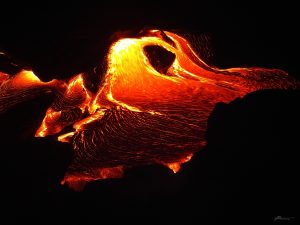16 December 2016
New equation describes how Earth cooled from magma into rock
Posted by dgaristo

Scientists are learning about how historic magma oceans on earth cooled into rock by creating an equation that predicts the melting of magnesium silicate. Credit: Paul Bica (CC BY 2.0, Flickr)
By Ula Chrobak
A new mathematical model shows strong evidence that when Earth formed, it cooled from the inside out rather that bottom up. Scientists who presented the research at the 2016 American Geophysical Union Fall Meeting said the new model helps scientists better understand Earth’s early history—how it cooled and became the rocky planet it is today.
Billions of years ago, deep magma oceans covered Earth and extended to its core. Today, Earth’s interior is mostly solid and made of silica-containing rocks. Using a new equation that describes the melting of one silicate mineral—magnesium silicate—scientists think they better understand how the magma oceans cooled and formed the rocks of Earth’s crust and mantle.
Many scientists have used equations to describe the melting and crystallizing properties of magnesium silicate, a compound made of magnesium, silicon, and oxygen. These equations predict how changes in temperature and pressure affect the mineral’s behavior. But their efforts have produced multiple different models that often don’t agree with each other or with experimental lab data on the mineral’s melting, according to Aaron Wolf, a physicist at the University of Michigan and lead author of the new study.
“There’s currently a debate [about how the magma oceans cooled],” Wolf said. “And we wanted to shine some light on it.”
Previous models have shown that the mineral crystallized at high pressures. This led researchers to believe the magma oceans turned into rock from their bottom depths, which is how many materials turn from liquid to solid. Water is unusual because it is a rare case of a liquid freezing from the surface down, Wolf said.
In the new study, Wolf and his team chopped apart and reordered older models to create a new equation of magnesium silicate’s behavior. Wolf was able to use a relatively simple equation with fewer variables than others to show how magnesium silicate behaves at high temperatures and pressures.
“That [behavior] was hidden previously,” Wolf said. “But by using familiar models put together we were able to reveal that.”
The new equation shows the mineral reacts differently to changes in pressure and temperature than previously thought. With increasing pressure, the individual molecules form chains and become solid—to an extent. Too much pressure breaks them apart and the mineral becomes liquid again. This behavior supports the more recent view that Earth started solidifying about two thirds down from its surface and then continued outward, both up toward the surface and down toward the core, according to Wolf.
The researchers put the equation to the test by seeing whether it matched up with experimental lab studies and simulations of the mineral’s melting. In both cases, it held up.
“This [equation] is agnostic: it doesn’t care if it’s experiments or if it’s simulations because the description is sufficiently simple,” Wolf said.
If the silicates crystallized from the center out, Earth may have once had distinct inner and outer magma oceans separated by a solid boundary, said Lars. P. Stixrude, a mineral physicist at University College London who was not involved with the research.
These distinct oceans could potentially have developed their own chemical properties, which might be able to explain inconsistencies in rock qualities that scientists have observed in today’s inner Earth, Wolf said. Next, he hopes to move his equation into a larger model of molten Earth cooling.
—Ula Chrobak is a science communication graduate student at UC Santa Cruz.


 GeoSpace is a blog on Earth and space science, managed by AGU’s Public Information staff. The blog features posts by AGU writers and guest contributors on all sorts of relevant science topics, but with a focus on new research and geo and space sciences-related stories that are currently in the news.
GeoSpace is a blog on Earth and space science, managed by AGU’s Public Information staff. The blog features posts by AGU writers and guest contributors on all sorts of relevant science topics, but with a focus on new research and geo and space sciences-related stories that are currently in the news.